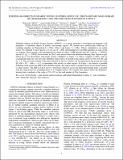Files in this item
Substellar Objects in Nearby Young Clusters (SONYC) IX : the planetary-mass domain of Chamaeleon-I and updated mass function in Lupus-3
Item metadata
| dc.contributor.author | Mužić, Koraljka | |
| dc.contributor.author | Scholz, Alexander | |
| dc.contributor.author | Geers, Vincent C. | |
| dc.contributor.author | Jayawardhana, Ray | |
| dc.date.accessioned | 2015-10-09T15:10:01Z | |
| dc.date.available | 2015-10-09T15:10:01Z | |
| dc.date.issued | 2015-09-10 | |
| dc.identifier | 220936891 | |
| dc.identifier | d8832508-8beb-40ac-84e8-44769a89f295 | |
| dc.identifier | 84941566064 | |
| dc.identifier | 000362083700075 | |
| dc.identifier.citation | Mužić , K , Scholz , A , Geers , V C & Jayawardhana , R 2015 , ' Substellar Objects in Nearby Young Clusters (SONYC) IX : the planetary-mass domain of Chamaeleon-I and updated mass function in Lupus-3 ' , Astrophysical Journal , vol. 810 , no. 2 , 159 . https://doi.org/10.1088/0004-637X/810/2/159 | en |
| dc.identifier.issn | 0004-637X | |
| dc.identifier.other | BibCode: 2015ApJ...810..159M | |
| dc.identifier.other | ArXiv: http://arxiv.org/abs/1507.07780v2 | |
| dc.identifier.uri | https://hdl.handle.net/10023/7637 | |
| dc.description | This work was co-funded by NSERC grants to R.J. Date of Acceptance: 14/07/2015 | en |
| dc.description.abstract | Substellar Objects in Nearby Young Clusters—SONYC—is a survey program to investigate the frequency and properties of substellar objects in nearby star-forming regions. We present new spectroscopic follow-up of candidate members in Chamaeleon-I (~2 Myr, 160 pc) and Lupus 3 (~1 Myr, 200 pc), identified in our earlier works. We obtained 34 new spectra (1.5–2.4 μm, R ~ 600) and identified two probable members in each of the two regions. These include a new probable brown dwarf in Lupus 3 (NIR spectral type M7.5 and (Teff =2800 K), and an L3 (Teff =2200 K) brown dwarf in Cha-I, with masses below the deuterium-burning limit. Spectroscopic follow-up of our photometric and proper motion candidates in Lupus 3 is almost complete (>90%), and we conclude that there are very few new substellar objects left to be found in this region, down to 0.01–0.02 MΘ and AV ≤ 5. The low-mass portion of the mass function in the two clusters can be expressed in the power-law form dN/dM α M-α, with α∼0.7, in agreement with surveys in other regions. In Lupus 3 we observe a possible flattening of the power-law IMF in the substellar regime: this region seems to produce fewer brown dwarfs relative to other clusters. The IMF in Cha-I shows a monotonic behavior across the deuterium-burning limit, consistent with the same power law extending down to 4–9 Jupiter masses. We estimate that objects below the deuterium-burning limit contribute of the order of 5%–15% to the total number of Cha-I members. | |
| dc.format.extent | 16 | |
| dc.format.extent | 2072850 | |
| dc.language.iso | eng | |
| dc.relation.ispartof | Astrophysical Journal | en |
| dc.subject | Brown dwarfs | en |
| dc.subject | Open clusters and associations: individual: Chamaeleon I | en |
| dc.subject | Lupus 3 | en |
| dc.subject | Stars: formation | en |
| dc.subject | Stars: luminosity function | en |
| dc.subject | Mass function | en |
| dc.subject | QB Astronomy | en |
| dc.subject | QC Physics | en |
| dc.subject | 3rd-DAS | en |
| dc.subject.lcc | QB | en |
| dc.subject.lcc | QC | en |
| dc.title | Substellar Objects in Nearby Young Clusters (SONYC) IX : the planetary-mass domain of Chamaeleon-I and updated mass function in Lupus-3 | en |
| dc.type | Journal article | en |
| dc.contributor.institution | University of St Andrews. School of Physics and Astronomy | en |
| dc.identifier.doi | 10.1088/0004-637X/810/2/159 | |
| dc.description.status | Peer reviewed | en |
| dc.identifier.url | http://adsabs.harvard.edu/abs/2015ApJ...810..159M | en |
This item appears in the following Collection(s)
Items in the St Andrews Research Repository are protected by copyright, with all rights reserved, unless otherwise indicated.

